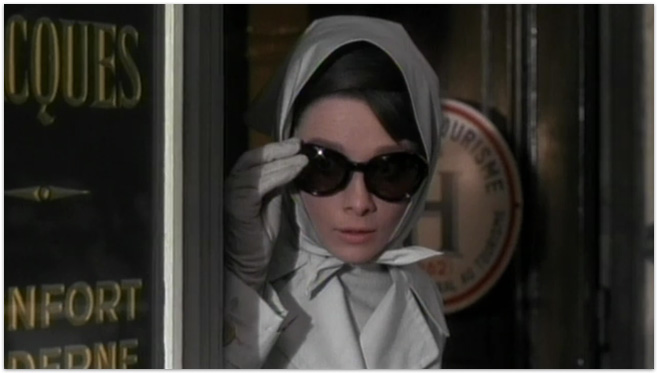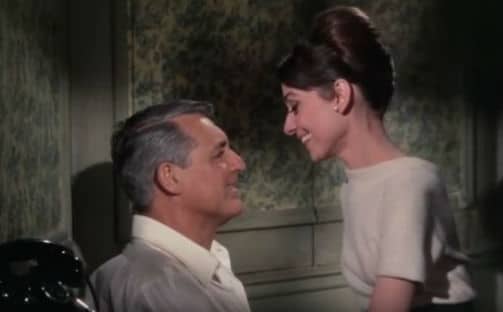Audrey Hepburn and Cary Grant are two names that are
synonymous with glamour, sophistication, and the very best in romantic comedy.
While it would seem an obvious choice to cast the two, who shared similar
improvisational acting styles and status as box-office favorites, together
Hepburn and Grant only costarred in one film, 1963‘s cold-war thriller, Charade. While CIA agents, Nazi gold,
and murder may be a far cry from the romantic comedies that both actors built
their careers upon, the duo exude such elegance, wit, and chemistry throughout
the film that cinema buffs can’t help regretting that they didn’t recapture the
same magic in another collaboration. A prime example of cold-war suspense and
Hepburn and Grant at their finest, Charade
is a must-see for classic and modern film fans alike.
 |
| Audrey Hepburn: Acrtress, philantrophist...secret agent?! |
The story begins as Regina, ‘Reggie’ Lampert meets
debonair Peter Joshua during a ski trip. While the pair share obvious
chemistry, any chance at romance is held at bay when he learns of her crumbling
marriage. Upon returning home to Paris, she is stunned to learn that her
husband was killed when an unknown assailant threw him from a train. It is then
revealed that her husband was wanted by the US government for his part in the
theft of two million dollars in confiscated Nazi gold bullion. Making matters
worse, her husband’s accomplices return in pursuit of their share of the gold
and will stop at nothing to get it. In the midst of this chaos Reggie enlists
the aid of and embarks upon a romance with Peter, who possesses dangerous
secrets of his own. The pair are then drawn into a web of theft, deception, and
murder as they struggle to get to the gold before the thieves can.
Often referred to as ‘the best film that Hitchcock
never made’, Charade has all the
suspense of a Hitchcock thriller with an added bonus of romance and humor. The
elaborate murders, Macguffin item that holds the key to the stolen gold, and
final character reveal create a twisting plot that serves as a perfect nod to
Hitchcock. Even the use of the director’s favorite leading man, Cary Grant,
follows in the tradition of the ‘master of suspense’. What sets Charade apart, however, is the way in
which the story refuses to take itself too seriously. Even in the midst of its
most tense moments, the script still finds humor in the absurdity of the
characters and the outlandish situations that they find themselves in. The
spyjinks work so well in large part due to the light tone with which they are
approached as everything from the bodies that continue to pile up to sparks
that fly between Hepburn and Grant are viewed through a lens of dry humor.
Through this humor, audiences can enjoy the ride without completely suspending
their disbelief assured that both they and the characters are in on the joke.
 |
| Cold-war comedy |
The film also outdoes Hitchcock in the sheer fun of
its romance. While Hitchcock’s films are known for melodramatic portrayals of
love at first sight, Reggie and Peter’s relationship progresses over the course
of the film. The film also doesn’t shy away from love’s inevitable conflicts as
its leads bicker and argue throughout their adventures. By showing a more
gradual progression of a relationship and including such mundane details as
lovers’ spats the film adds a level of authenticity to the romance, which
viewers can see shades of their own relationships in. Finally, falling in love
has rarely looked so outright fun as it does in Charade. Just like many offscreen couples, Peter and Reggie build
their relationship on a foundation of laughter as they tease, banter and joke
with one another every step of the way. Through Grant and Hepburn’s sparkling
chemistry the relationship maintains a playful sexiness that avoids both the
histrionics of many classics and the immaturity of many modern rom-coms. Suspenseful,
sexy, and with a tongue firmly in cheek, Charade
is a blend of cinema at its most entertaining.
The uniformly excellent cast weave a web of intrigue,
suspense, and romance that will keep viewers guessing until the film’s final
frame. James Coburn, George Kennedy, and Ned Glass by turns tingle the spine
and tickle the ribs as villains Tex, Scobie, and Gideon who would be far more
formidable if only they could stop fighting amongst themselves. Walther Matthau
infuses his CIA agent with dry humor, adding a level of humanity to what easily
could have been a stock role. Even while surrounded by a talented cast Hepburn
and Grant shine like the stars that they are. Grant strikes the ideal balance
between sophistication and warmth in his role as Peter, leaving little wonder
as to why Reggie falls for him even as she learns his many secrets and lies.
Hepburn is nothing short of a delight as the well-meaning but scatter-brained
Reggie, and proves that she can tackle drama and comedy with equal skill. The
scenes that the pair share are some of the best in romantic comedy as they play
with both gender and genre conventions as Hepburn aggressively pursues the much
older and more worldly Grant, who in turn switches sides as often as he
switches his ‘drip-dry’ suits.
Packed with enough twists and turns to keep even the
most seasoned viewer guessing, Charade is a vintage thrill ride that can still
hold its own in the modern era of gritty filmmaking. Harkening back to an era
in which suspenseful did not necessarily mean bleak, the film strikes a perfect
balance between edge-of-your-seat drama and frothy romantic comedy. With all
the thrills and romance of the greatest suspense films and plenty of laughs
along the way Charade is a film that
many a director wishes they had made.
 |
| Finally, a rom-com that's actually romantic and funny! |



